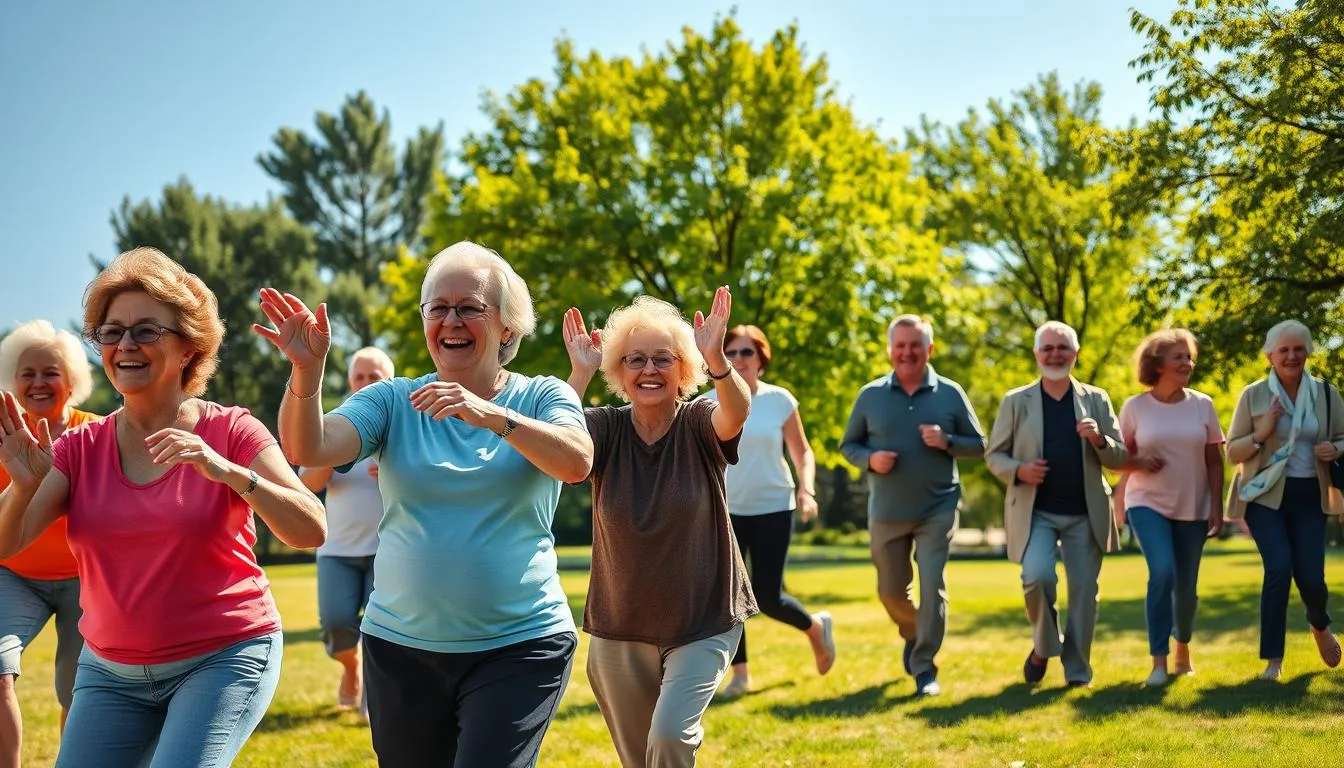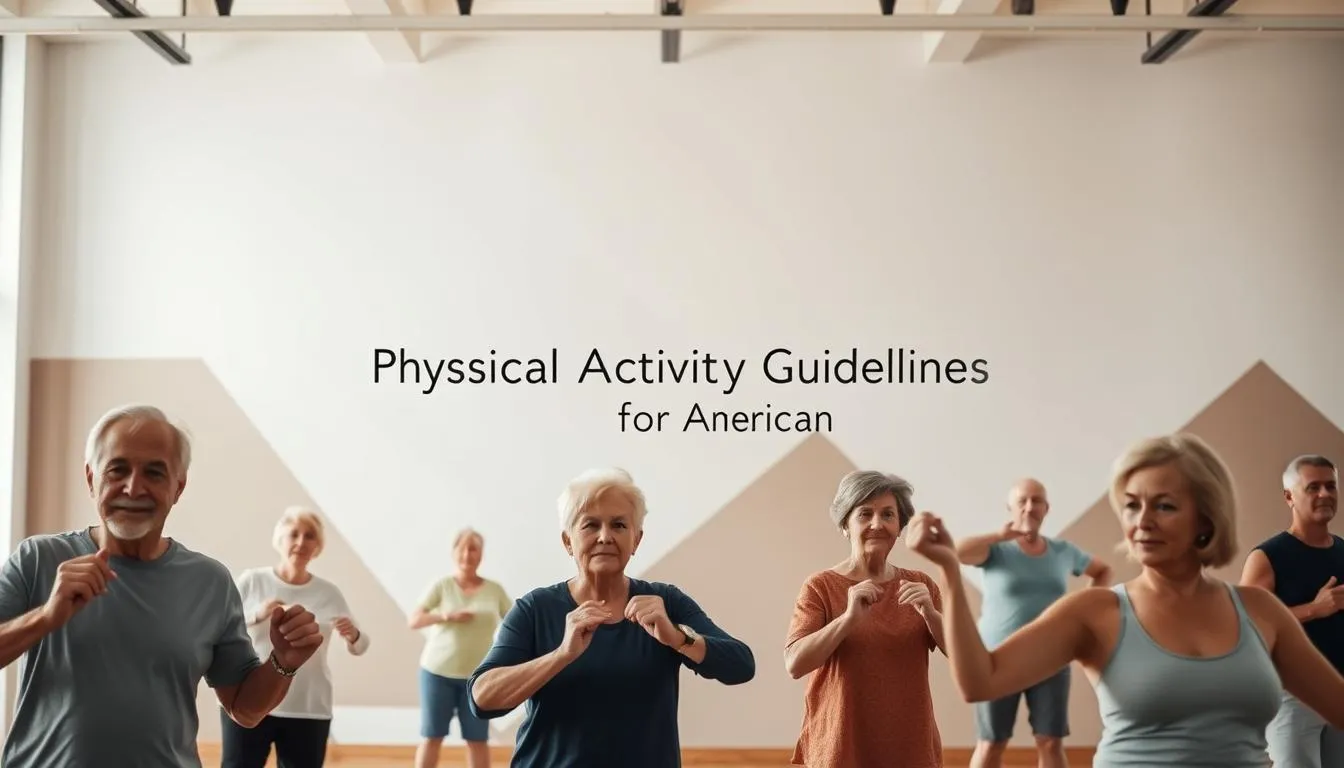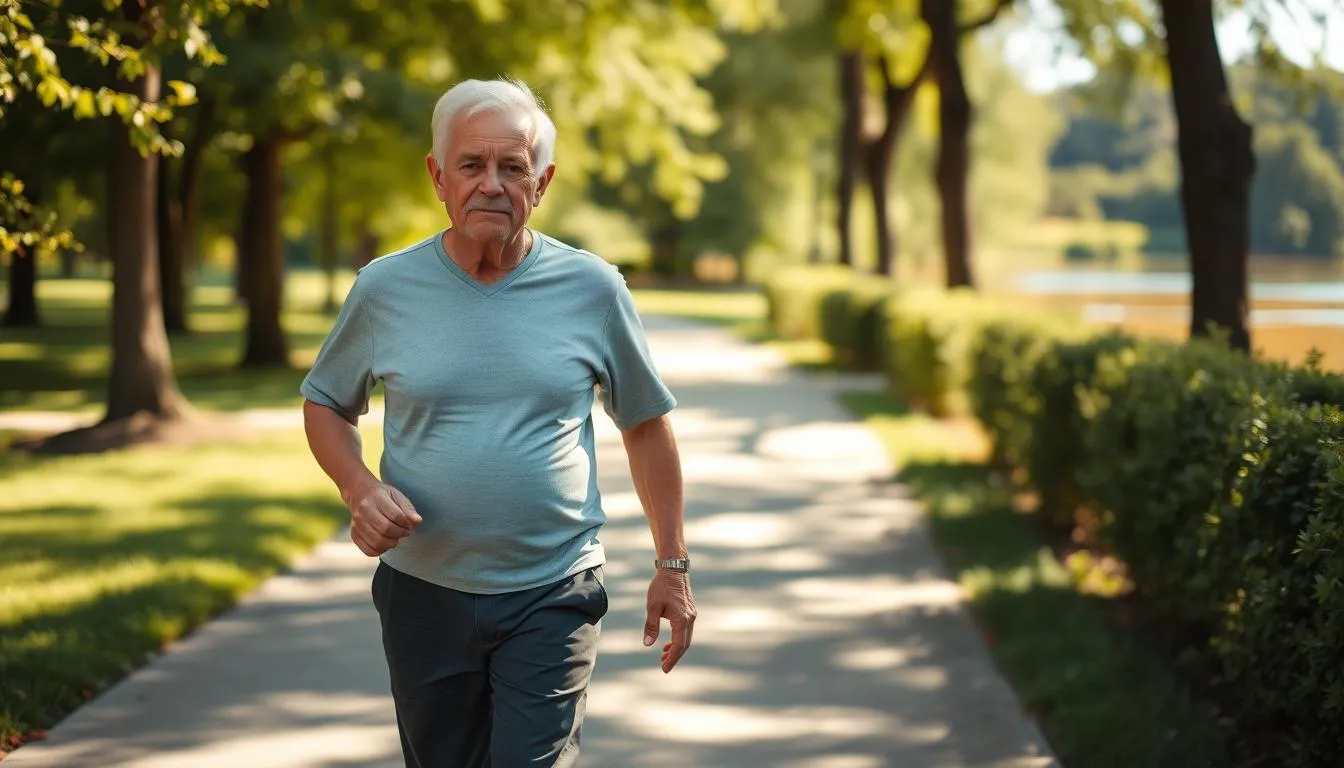Surprising fact: fewer than one-third of Americans age 65 and up meet federal guidelines for weekly physical activity, yet simple steps can change that fast.
This friendly, step-by-step guide shows simple, safe ways to stay active at home and in the community. You’ll learn what to do each week, how many minutes to aim for, and which activities build strength, flexibility, and balance.
Structured options and everyday movement both count, so it is easier to stick with a routine. National guidance recommends a mix of heart-pumping movement and muscle work, and many community choices are designed for adults who want to stay independent.
Start small—progress is possible at any age. The guide includes sample weekly schedules, short sessions that add up, and clear cues for safe progression. It also points to evidence-based offerings like EnhanceFitness and SAIL and notes national support from CDC and NCOA for proven options.
Key Takeaways
- Less than one-third of Americans 65+ meet recommended physical activity levels.
- Both structured program options and daily activities count toward goals.
- A mix of aerobic and muscle-strength work improves fitness and health.
- Short sessions and gradual progress help build lasting habits.
- Evidence-based offerings and national support make safe choices accessible.
Why staying active matters for older adults in the United States
Staying active keeps people moving, thinking clearly, and enjoying daily life longer. Physical activity supports heart and brain health, helps manage diabetes, and eases stiff joints so adults can keep doing what they love.
Consistent activities also improve sleep, boost energy, and lift mood, making each day feel easier. Small sessions of walking, gentle chair routines, or water classes all count and fit many comfort levels.

Staying active lowers the risk of falls by improving leg strength, balance, and reaction time — a key part of injury prevention. Community options give trained leaders, social support, and safe progressions tailored to people 65+.
Even 10–15 minutes a day adds up. Combining strength, balance, and flexibility helps maintain bone density and joint range of motion, which supports independence in everyday tasks.
- Choose activities you enjoy — consistency beats intensity for long-term health.
- Start slow with modifications for chronic pain or fatigue; steady progress is safe and effective.
- Group movement reduces loneliness and keeps motivation high; find an evidence review here.
Know the Physical Activity Guidelines for Americans
Understanding the national activity targets helps you balance heart health and muscle strength each week. Physical activity guidelines call for two types of movement: aerobic work for cardiorespiratory fitness and muscle‑strengthening for everyday function.

Aerobic activity vs. muscle‑strengthening: what to include each week
Aerobic activity supports heart and lung health. Examples include brisk walking, cycling, swimming, water aerobics, or low‑impact dance.
Muscle‑strengthening targets major areas—legs, hips, back, abdomen, chest, shoulders, and arms. Use bodyweight moves, resistance bands, or light weights two or more nonconsecutive days.
How many minutes and how often: CDC and AHA-aligned targets
Aim for about 150 minutes per week of moderate aerobic activity (roughly 30 minutes on five days). The American Heart Association also recommends 150 minutes weekly.
| Type | Weekly target | Practical example |
|---|---|---|
| Aerobic | ≈150 minutes | 30 min brisk walk, 5 days |
| Strength | 2+ days | Full‑body routine with bands |
| Flexibility/Balance | Most days | Daily stretches, short balance drills |
“Moderate” intensity means you can talk but not sing during activity — a simple self‑check without gadgets. Split time into 10–15 minute bouts if needed. Rest between strength days so muscles recover. Over time, build up slowly; consistency over weeks matters more than any single session.
Build your week: a step‑by‑step plan you can follow
Plan a simple week of movement that fits your routine and feels doable every day. This short template hits about 150 minutes of moderate activity while leaving time to rest and recover.

Sample weekly schedule
Try this example cadence: Mon/Tue/Fri — two 15‑minute walks. Wed/Sat — one 30‑minute session of cycling, swimming, or water aerobics. Thu/Sun — lighter days with gentle stretching or one full rest day.
Short sessions add up
Split time into 10–15 minute blocks. Do a 10‑minute mobility break after breakfast and a 10‑minute balance routine before dinner. Two short sessions count the same as one longer one.
Progress safely
Increase by about 5 minutes per session or add one extra walking day every 1–2 weeks. Rate sessions as easy, moderate, or a bit challenging, and only step up when most feel easy to moderate.
- Track minutes with a phone timer, kitchen timer, or calendar checkmarks.
- Alternate higher‑effort days with easier ones to manage soreness.
- Keep variety—change routes, music, or activity types to stay motivated.
Strength training made simple at home
A six‑minute starter helps you safely add strength and mobility to daily life. Begin with a light warm‑up: march in place or walk a hallway for 2 minutes to raise blood flow.
Six‑minute starter: wall pushups, heel raises, and knee lifts
Try a short circuit: one minute each of wall pushups, seated heel raises, seated knee lifts, shoulder blade squeezes, toe taps, and ankle rotations. Aim for controlled movement, not speed.
- Wall pushups: stand about 3 feet from the wall with a straight spine; perform 8–12 reps.
- Heel raises: seated, rise onto the balls of the feet for 20 reps.
- Knee lifts: seated, lift each leg 2–3 inches and hold 3 seconds, 8–12 reps each.
Core and posture: abdominal contractions and shoulder blade squeezes
Add gentle core work: lie on your back, tighten the abs, hold for three breaths, and repeat 10 times. This builds trunk support for better position during daily tasks.
For posture, squeeze shoulder blades and hold 3 seconds; repeat 8–12 times. Keep shoulders down—avoid shrugging to prevent neck tension.
Lower body focus: toe taps and ankle rotations for muscle and mobility
Finish with toe taps (20 reps) and ankle rotations (5 circles each direction). These drills improve balance, joint range, and calf strength for safer walking.
- Do strength training 2–3 nonconsecutive days per week, leaving 48+ hours between similar sessions.
- Progress by adding 2–3 reps, a second set, or moving from seated to supported standing.
- Optional: later use light dumbbells or resistance bands for gradual gains.
Stop any movement that causes sharp pain. Modify ranges to match comfortable mobility and check with a provider if you have health concerns. A local class or guided session can help refine form.
Flexibility and balance for fall prevention
Improving range of motion and steadiness takes only minutes but yields big safety gains. Daily stretches ease neck and upper‑back stiffness so turning to look or reach feels smoother.
Daily stretches: neck and upper back for range of motion
Do neck turns and an upper‑back reach. Hold each stretch 10–30 seconds and repeat 3–5 times. These simple moves keep mobility for reaching shelves and scanning while walking.
Balance boosters: shifting weight and single‑leg stands
Practice shifting weight side to side near a sturdy counter, then try single‑leg stands with light fingertip support. Hold 10–30 seconds, repeat 3 times per side, and rest as needed.
Tai chi and yoga as gentle, evidence‑supported options
Mindful movement like tai chi or gentle yoga builds steadiness, body awareness, and confidence with daily activities.
“Short sessions add up—try 5 minutes marching, 5 minutes balance work, then a few minutes of stretching.”
- Weave balance into routines (stand on one leg while brushing teeth).
- Focus on ankle and hip mobility to handle curbs and uneven sidewalks.
- Use a chair or wall for safety and practice at a consistent time each day.
For guided moves and more ideas, see fall prevention exercises.
How to choose older adult exercise programs
A reliable option blends proven results, trained leaders, and ways to modify movements. Look for classes that list outcomes like improved balance, less pain, or better walking speed.
Evidence-based labels matter because they show the activity was tested and helped real participants. AAEBI (Arthritis‑Appropriate, Evidence‑Based Interventions) is useful for people managing joint symptoms.
Community funding and organizational support
Local access often depends on grants. The ACL, OAA Title III‑D, and CDC help fund proven options so centers can offer low-cost classes.
Ask your local senior center, YMCA, or health department what they host and whether scholarships or sliding fees exist.
Examples to explore
SAIL meets three times weekly with warm‑ups, aerobics, balance, strength, and stretching in seated or standing formats.
Walk with Ease is a structured walking plan that helps manage joint pain while increasing distance and pace.
Social and targeted choices
Bingocize pairs bingo with short movement and health tips in 10‑week sessions.
Fit & Strong! combines strength, flexibility, and behavior strategies for people with lower‑extremity osteoarthritis.
Tai Ji Quan: Moving for Better Balance focuses on progressive balance and mobility for fall control prevention.
| Option | Focus | Session length/frequency | Who benefits |
|---|---|---|---|
| SAIL | Strength, balance, aerobics, stretch | 1 hour, 3x/week | General function and fall risk |
| Walk with Ease | Walking plan for pain and endurance | 30–60 min, flexible schedule | Those managing joint pain |
| Bingocize | Social engagement + short activity | 10‑week units | Social participants who want fun |
| Fit & Strong! | Osteoarthritis management + exercise | 8 weeks | Lower‑extremity arthritis |
| Tai Ji Quan | Balance and mobility | Progressive classes | Fall prevention |
Before joining, confirm leaders are trained, ask about progress tracking, and make sure modifications are offered for safety. For federal guidance and tips on activity, see this physical activity tips.
Program spotlight: EnhanceFitness for strength, balance, and social connection
EnhanceFitness blends guided movement and friendly coaching so people gain strength, balance, and social ties. Certified instructors lead both in‑person and virtual classes. Many classes run at YMCAs and community centers.
What a 1-hour class includes
Typical one‑hour flow is clear and steady. Instructors open with a warm‑up, move into low‑impact aerobics, then targeted strength sets.
Balance drills come next, and a calm stretch finishes the session. Pace and options are tailored so participants at different levels feel safe.
Proven benefits
Recognized by the CDC as an AAEBI, EnhanceFitness reduces arthritis pain and boosts everyday function. Decades of delivery across 44 states show better physical function, fewer falls, and stronger mood.
About 60% of participants are in their 70s and over 20% are 80+, which shows the class is adaptable and welcoming.
Find classes near you and virtual options
The program offers a true “fitness family” feel; instructors often open virtual rooms early so people can chat and connect. Try one session at a YMCA or join online if travel is hard.
| Component | Typical time | Focus |
|---|---|---|
| Warm‑up | 10 min | Mobility, heart rate rise |
| Low‑impact aerobics | 15 min | Cardio endurance |
| Strength sets | 20 min | Functional muscle work |
| Balance + stretch | 15 min | Stability and flexibility |
Want to join or lead? Search projectenhance.org/locations to find nearby classes or learn about instructor training at projectenhance.org/ef-become-instructor. Signing up for a 16‑week block helps build confidence and steady progress.
Safety, accessibility, and support
Simple adjustments and the right support help people stay active without added risk. Before starting, check with your health care provider so activity plans fit your health, medications, and mobility level.
Check with your health care provider and tailor for mobility
Ask for a quick check‑in to personalize care around joint issues, heart conditions, or new medicines. A short conversation can help you choose safe intensity and avoid strain.
Use chairs, walls, and community classes for safer progression
Begin with supported moves using a chair back, countertop, or wall. These props let you practice posture and build steady balance without fear.
“Aim for gentle muscle tiredness, not sharp pain; stop and modify if something feels wrong.”
- Set up a clutter‑free space, good lighting, and sturdy shoes to lower trip risks.
- Try seated routines first and add standing steps as confidence grows.
- Take a rest day after harder sessions and alternate muscle groups to recover.
- Bring water and a light snack for morning sessions or longer walks.
Join community classes led by trained instructors when possible—they offer real‑time form checks and modifications. Social support helps you stay consistent and enjoy each day more.
Conclusion
Tiny, consistent minutes of movement each day build strength, steadiness, and better health over weeks.
Mix aerobic activity with short strength sets and balance practice to cover core needs. These bits of movement fit into any day and add up across a week.
Choose what you enjoy — walking with a friend, a gentle class, or short home routines — so the plan sticks. Steady training protects muscles and supports everyday tasks.
Balance drills and mobility work reduce falls and improve confidence. For evidence on multimodal routines and fall prevention, see this multimodal exercise review.
Next step: pick one example from this guide and schedule it for tomorrow. Small, safe progress over time brings real gains in strength, balance, and health.
FAQ
What are safe weekly targets for staying active according to U.S. guidelines?
The Physical Activity Guidelines for Americans and the CDC recommend at least 150 minutes of moderate-intensity aerobic activity per week, or 75 minutes of vigorous activity, plus muscle-strengthening activities on two or more days. Break sessions into 10–15 minute blocks if needed to build up to the total.
How do I mix aerobic activity and strength training in one week?
Aim for three to five days of moderate aerobic work such as walking, cycling, or water aerobics and two nonconsecutive days for strength training that targets major muscle groups. Include balance and flexibility work several times weekly to reduce fall risk.
Can short sessions really add up if I can’t do long workouts?
Yes. Short bouts of 10–15 minutes spread across the day count toward weekly totals and improve fitness when done consistently. Frequent short sessions also lower injury risk and fit better into busy or limited-mobility routines.
How should I progress safely when increasing time or intensity?
Increase total minutes by no more than 10% per week, add one extra day at a time, and raise intensity gradually. Watch for pain, consult your clinician if you have chronic conditions, and use chairs or walls for support during new movements.
What are simple strength moves I can do at home in six minutes?
Try wall pushups, heel raises, and knee lifts performed in sets with short rests. These build upper and lower body strength and require minimal equipment. Start with fewer repetitions and increase as you feel stronger.
Which balance and flexibility activities help prevent falls?
Daily stretches for the neck, upper back, and hips improve range of motion. Balance drills such as weight shifts and single-leg stands, plus Tai Chi or gentle yoga, have strong evidence for reducing fall rates.
How do I pick a community class or evidence-based option?
Look for programs recognized by the Administration for Community Living (ACL) or those designated as evidence-based by the Administration for Community Living’s Evidence-Based Leadership. Examples include SAIL, Walk with Ease, Bingocize, Fit & Strong!, and Tai Ji Quan.
What does an EnhanceFitness class typically include?
A one-hour EnhanceFitness session usually blends aerobic warm-up, strength training with light weights or bands, stretching for flexibility, and balance practice. It supports strength, mobility, and social connection and often reports reduced falls and improved arthritis symptoms, and consider exploring gentle mobility exercises for additional techniques.
Are virtual classes as effective as in-person sessions?
Virtual options can be effective when led by trained instructors and adapted for safety. They increase access for people with transportation or mobility limits. Ensure the class provides clear modifications and ways to connect with the instructor, and consider exploring adaptive fitness modifications for additional techniques.
What funding or community supports can help me join classes?
Many community centers and aging services receive support from the ACL, Older Americans Act Title III-D, and CDC grants. Check local senior centers, YMCAs, and health departments for low-cost or subsidized options.
How can I tailor activities for limited mobility or chronic conditions?
Work with your health care provider and a certified instructor to adapt movements. Use seated versions, a stable chair, or walls for balance. Start slowly, prioritize pain-free ranges, and focus on functional moves that match daily needs.
